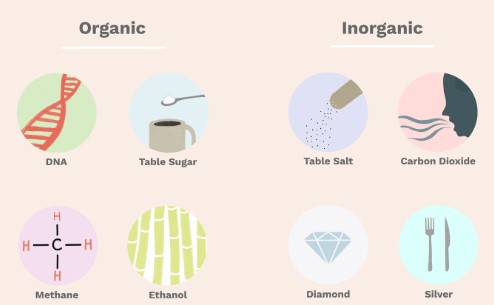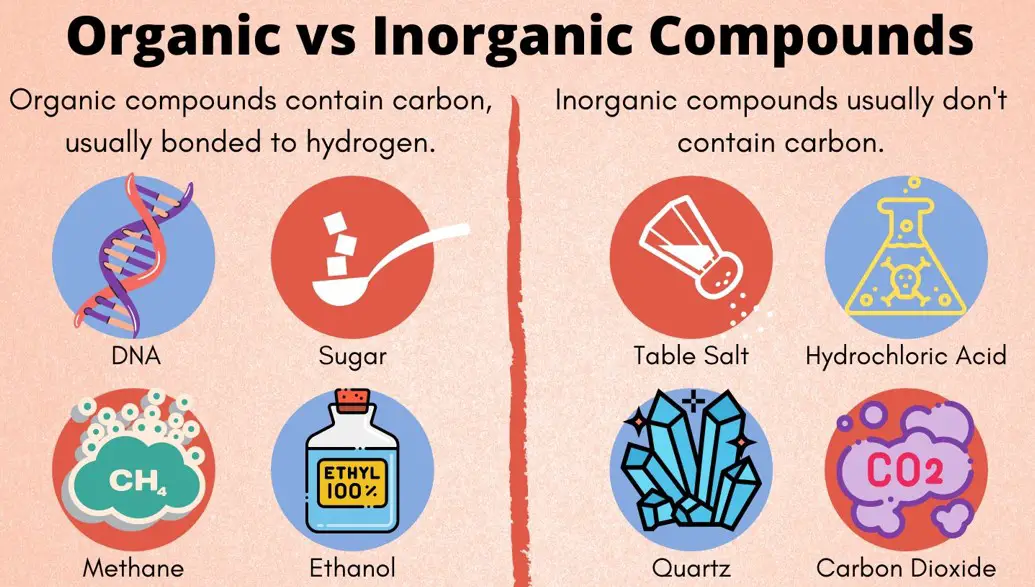Organic and inorganic substances are all around us, and in many cases, they can look similar. However, there are some key differences between the two that can have an impact on our health and the environment. In this blog post, we will explore the differences between organic and inorganic substances and explain how they are used in everyday life.
In this blog post, we will explore the differences between organic and inorganic substances and explain how they are used in everyday life.
Characteristics of organic substances

Organic substances, such as carbohydrates, proteins, and fats, are composed of molecules primarily made of carbon and hydrogen atoms. These molecules are produced by plants and animals and are essential components of all living organisms.
Examples include water, minerals, and salts. The key difference between organic and inorganic substances is that organic substances are part of living organisms while inorganic substances are not.
Organic substances are composed of complex molecules that contain carbon and hydrogen atoms while inorganic substances are composed of simpler molecules that lack these atoms. Furthermore, organic substances are often found in nature while inorganic substances are usually man-made.
Characteristics of inorganic substances

Organic and inorganic substances are the two main types of materials that make up our world. Organic substances are those that contain carbon, while inorganic substances do not. The biggest difference between organic and inorganic substances is that organic substances have complex molecular structures while inorganic substances have simpler ones.
The biggest difference between organic and inorganic substances is that organic substances have complex molecular structures while inorganic substances have simpler ones. Organic substances are usually composed of longer chains of molecules, while inorganic substances are composed of smaller molecules. Organic substances are also usually more reactive than inorganic substances, as they can form more chemical bonds.
Inorganic substances are usually much more stable than organic substances, which makes them ideal for use in industrial processes. In terms of their physical properties, organic substances tend to be softer and more malleable and inorganic substances tend to be harder and more brittle.
Difference between organic and inorganic substances

Organic and inorganic substances have distinct differences that can make them easy to identify. Organic substances are those that contain carbon and hydrogen, while inorganic substances do not contain these elements.
Organic substances are generally found in living things, such as plants and animals, and include proteins, carbohydrates, and lipids. Inorganic substances, on the other hand, are not found in nature and are primarily made up of metals and minerals. They are often used in industrial and manufacturing processes, such as in fertilizers and cleaning agents.
Organic substances are also more prone to chemical reactions than inorganic substances.
Examples of organic and inorganic substances
Organic and inorganic substances are two distinct types of substances that are found in nature. Organic substances are those that contain carbon and are typically derived from living organisms, such as plants, animals, and bacteria. These substances are often naturally occurring and are the building blocks of life.
Inorganic substances, on the other hand, are typically not derived from living organisms and can include minerals, water, and air. Inorganic substances can range from simple elements like chlorine and iron to complex compounds like carbon dioxide and quartz.
The main difference between organic and inorganic substances is that organic substances can be broken down and used as a source of energy, while inorganic substances cannot.
Health implications of organic and inorganic substances

Organic and inorganic substances are two categories of substances that have vastly different effects on our health. Organic substances are derived from living organisms or their byproducts, and they often contain essential vitamins and minerals that are beneficial to our bodies.
While inorganic substances may not be as beneficial as organic substances, they can still be beneficial when used in moderation. The key is to understand the difference between organic and inorganic substances and to learn how to use them in a safe and effective way.
By doing so, we can enjoy the health benefits of both organic and inorganic substances while avoiding any potential risks associated with their misuse.
Bottom Line
In conclusion, the main difference between organic and inorganic substances is that organic substances are composed of carbon atoms, while inorganic substances are not. Additionally, organic substances can be found in living things, while inorganic substances are either created synthetically or are naturally occurring. Organic substances tend to be more complex and are often derived from living organisms, while inorganic substances tend to be simpler and are usually synthesized from inanimate sources.

